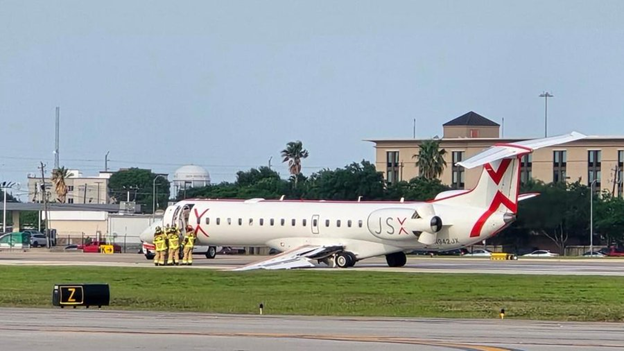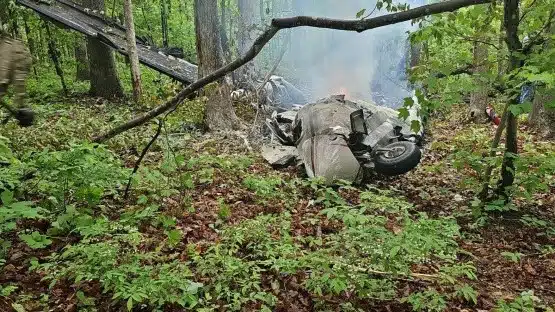ARFF Daily News
Published on:
Monday the 6th of May, 2024
Small plane at Hobby Airport has landing gear collapse, 1 person injured
HOUSTON - A small JSX plane at Hobby Airport experienced a landing gear collapse on Friday.
According to officials, the landing gear touched down on Runway 4 of the airport before the collapse happened. The plane eventually stopped near the area where the planes park but went off the roadway into a ditch.
There were 31 people on board and all got off the aircraft safely, but one crew member was taken to the hospital with minor injuries.
The remaining passengers and crew members were safely taken by bus to Wilson Aviation.
Emergency crews arrived at the scene and the situation is being monitored.
JSX gave FOX 26 this statement: "JSX is aware of an incident that occurred on flight 284 from Dallas to Houston on Friday, May 3, 2024. JSX is cooperating with all authorities. The safety of our Customers and Crewmembers is our top priority and JSX will provide updates as they become available."
FAA representatives are investigating the incident site and the aircraft will be removed once they've left the scene.
https://www.fox26houston.com/news/small-plane-at-hobby-airport-has-landing-gear-collapse

An R Komor plane leaves the runway
The attempt to take off a plane of the airline R Komor ended in an accident. No deaths have been reported.
Written by NP
Launched at full throttle, the Folker 50 type aircraft of the R Komor company was unable to take off at the end of the runway at Bandar Es Salam airport in Moheli this Sunday morning. For reasons that remain to be determined, the plane ended up in the vegetation. According to the first people to go to help the passengers, there were serious injuries among them.
This accident raises serious questions among the Comorian population since it is the second incident of this type since the start of the year. On February 19, the same aircraft overran the runway at Anjouan airport this time. A tire had blown during landing. The Folker had been authorized to return to service after its maintenance.
https://www.zinfos974.com/un-avion-de-la-compagnie-r-komor-fait-une-sortie-de-piste/


Pilot hurt in single-engine plane crash in northern Indiana
by: Gregg Montgomery
LAPORTE, Ind. (WISH) — A pilot received a minor injury in a monoplane crash Saturday evening in northern Indiana, the La Porte County Sheriff’s Office says.
Capt. Derek Allen of the sheriff’s office says the 1952 single-engine Mooney M18C crashed about 6:20 p.m. Saturday in a harvested farm field along County Road 850 East north of County Road 150 North.
That’s about 7 miles south of the St. Joseph County town of New Carlisle, and a half-hour drive west of South Bend in northern Indiana.
No additional information was immediately available about the crash.
Saturday’s crash of a small plane was at least the third in Indiana since Thursday.

Update: Two confirmed dead in small plane crash in Fluvanna County
By Chris Graham
Update: Sunday, 6:55 p.m. Virginia State Police are now reporting that two people died in a small-plane crash in Fluvanna County on Sunday morning.
The crash was reported at 8:54 a.m. by residents living within the 200 block of Miles Jackson Road in Palmyra who called 911 concerning a low-flying plane and then what sounded like an explosion.
The Fluvanna County Sheriff’s Office, Virginia Conservation Police and Virginia State Police responded to search for wreckage and located the aircraft, which was on fire, in a densely wooded area off Miles Jackson Road.
The Palmyra, Fork Union, Kents Store and Lake Monticello fire companies responded to the scene to attend to extinguish the fire and assist law enforcement. Fluvanna County Emergency Services also responded to the scene.
State Police has confirmed that both occupants of the privately-owned, twin-engine aircraft did not survive the crash. VSP is still in the process of notifying the next of kin of the pilot and passenger.
Both bodies are being transported to the Office of the Chief Medical Examiner in Richmond for examination and autopsy.
The aircraft reportedly left the Manassas Regional Airport this morning and was flying to South Carolina.
There was a light rain in the area at the time of the crash.
The cause of the crash remains under investigation at this time by State Police, the FAA, which is currently on scene, and the NTSB.
First report: Sunday, 4:31 p.m. One person is dead from injuries in the crash of a small private plane in Fluvanna County on Sunday, per a report from the Virginia State Police.
Debris from the plane was located in a wooded area within the 200 block of Miles Jackson Road in Palmyra, a State Police spokesperson reported in an email.
The impact of the pre-9 a.m. Sunday crash caused parts of the aircraft to catch fire.
There is one confirmed fatality.
The crash remains under investigation at this time. Both the NTSB and FAA have been notified.
https://augustafreepress.com/news/developing-one-dead-on-sunday-in-small-plane-crash-in-fluvanna-county/

Boeing locks out firefighters after failed contract negotiations
By Caitlyn Freeman and Daniel Beekman
Seattle Times staff reporters
Boeing locked out its on-site firefighters at its Washington facilities early Saturday morning after contract negotiations with their union reached a standstill.
The lockout came after members of the International Association of Fire Fighters Local I-66 twice rejected Boeing contract offers in recent months and talks toward another offer broke down almost immediately Monday, the union said.
The Boeing firefighters are on hand for fueling and flights, do fire-prevention work and respond to accidents and emergencies at the company’s facilities, receiving about 200 calls each month, according to their union.
The union says Boeing’s latest contract offer includes “substandard wages” and requires firefighters to work 19 years before reaching their pay ceiling. Currently, other Boeing employees max out after five years of employment. The union also says its firefighters earn up to 30% less than those working at nearby fire departments.
Boeing said in a statement: “Despite extensive discussions through an impartial federal mediator, we did not reach an agreement with the union. We are disappointed the union chose not to even bring our offer to its members for one final vote. We have now locked out members of the bargaining unit and fully implemented our contingency plan with highly qualified firefighters performing the work of IAFF members.”
The lockout started at 12:01 a.m. Saturday, affecting about 130 Local I-66 members, said Matt Lowery, an IAFF strategic campaigns specialist. They’re normally stationed at sites in Auburn, Everett, Renton, Seattle and Moses Lake, according to the union.
“The people who work for Boeing are really dedicated. They believe in the company” and want to help it regain its reputation for safety, Lowery said. “So it’s too bad this is how it transpired.”
As of late Saturday afternoon, no new negotiations between Boeing and the union had been scheduled, he said.
The union says the lockout will negatively affect surrounding cities and counties, because local fire and emergency medical services will respond to any emergencies at Boeing facilities.
“The surrounding agencies are being told” by Boeing, “‘Hey, we might have somebody on-site but you’re still on the ball for all responses,'” Lowery said.
In a media fact sheet, Boeing said it expects no interruption of firefighting services at its facilities and will use non-IAFF firefighters to do the work. It said IAFF firefighters have always called on local departments during emergencies.
According to the fact sheet, the union’s proposed pay progression would result in the firefighters maxing out within six years of employment, which Boeing says is inconsistent with industry standards.
The company’s offer includes a new pay structure with an increase of $21,000 per year on average, according to the fact sheet. The average take-home pay of a Boeing firefighter in 2023 was $91,000, the company says.
Boeing said the union is asking for standards typically applied to local and municipal departments. It said the work being done by its firefighters is “completely different” and that its offer is similar to other industrial fire departments.
“The union is using standards that do not apply to this bargaining unit,” Boeing’s fact sheet said.
Casey Yeager, the Local I-66 president, said the firefighters deserve better compensation because the incidents they respond to are more dangerous than those faced by municipal departments. And if not contained quickly, Yeager said, they can “result in millions of dollars in damage to airplanes Boeing sells around the world.”
https://www.seattletimes.com/business/boeing-aerospace/boeing-locks-out-firefighters-after-failed-contract-negotiations/?utm_source=RSS&utm_medium=Referral&utm_campaign=RSS_boeing-aerospace

NTSB Prelim: Douglas C54D
(Pilot Stated) There Was “A Fire On Board” And That They Needed To Return To The Airport
Location: Fairbanks, AK Accident Number: ANC24FA029
Date & Time: April 23, 2024, 10:03 Local Registration: N3054V
Aircraft: Douglas C54D Injuries: 2 Fatal
Flight Conducted Under: Part 91: General aviation - Business
On April 23, 2024, about 1003 Alaska daylight time, a Douglas C54D (DC-4) airplane, N3054V, was destroyed when it was involved in an accident near Fairbanks, Alaska. The two pilots were fatally injured. The airplane was operated as a Title 14 Code of Federal Regulations Part 91 flight.
The accident airplane, owned and operated by Alaska Air Fuel, Inc., was transporting 3,400 gallons of unleaded fuel and two 100-gallon propane tanks. The airplane departed from the Fairbanks International Airport (FAI) at about 0955 Alaska daylight time (AKDT) with a destination of the Kobuk Airport (OBU) Kobuk, Alaska. Shortly after takeoff an eyewitness reported seeing the airplane flying to the west, with the far left engine (No. 1) not running. The witness also noticed a small, white plume of smoke coming from that engine. The witness reported the airplane began a turn to the south at which point he noticed the engine was on fire. Recovered surveillance video shows white smoke behind the number one engine, followed by flames. The video also revealed that seconds later a bright white explosion is seen just behind the number one engine followed by fragments of airplane wreckage falling to the ground.
The airplane then begins an uncontrolled descending left turn into terrain. The No. 1 engine separated from the wing about 100 ft above the ground and eventually came to rest on the frozen Tanana River.
A preliminary review of archived voice communication information from the Federal Aviation Administration (FAA) revealed that shortly after departure from FAI at 1,000, the pilot contacted the departure air traffic control (ATC) specialist on duty, stating that there was “a fire on board” and that they needed to return to the airport.
The accident airplane was equipped with Automatic Dependent Surveillance–Broadcast (ADS–B), which provides aircraft position information via satellite navigation or other sensors and periodically broadcasts it, enabling the aircraft to be tracked. The information can be received by air traffic control ground stations as a replacement for secondary surveillance radar, as no interrogation signal is needed from the ground.
According to archived FAA ADS-B data, after the airplane departed FAI, it initially proceeded southwest, then it turned westbound. The airplane then began a left turn back to FAI. The ADSB data eventually stopped near where the witness observed the accident airplane impact terrain.
The accident airplane was also equipped was Spidertracks. Spidertracks enables real-time flight tracking, automated flight watch, two-way communication, and flight data monitoring (FDM) for aircraft. The operator’s archived Spidertracks data has been collected for further analysis.
A large postcrash fire ensued, which incinerated much of the airplane's structure. The No.1 engine was recovered, and a detailed engine examination is pending.
FMI: www.ntsb.gov
NTSB Final Report: Quest Aircraft Co Inc Kodiak 100
'Airplane Bounced Twice On The Grass Runway, Resulting In The Nose Wheel Separating From The Airplane...'
Location: Lakeport, Florida Accident Number: ERA24LA093
Date & Time: January 19, 2024, 17:13 Local Registration: N5799
Aircraft: Quest Aircraft Co Inc Kodiak 100 Aircraft Damage: Substantial
Defining Event: Hard landing Injuries: 1 Serious, 4 None
Flight Conducted Under: Part 91: General aviation - Personal
Analysis: The pilot reported, “upon touchdown, the plane jumped back up as I reduced power all the way back.” He said that the airplane bounced twice on the grass runway, resulting in the nose wheel separating from the airplane. Subsequently, the nose landing gear strut dug into the ground, and the airplane nosed over. The airplane’s fuselage, wings, and empennage were substantially damaged. The pilot reported that there were no preimpact mechanical malfunctions or failures of the airplane that would have precluded normal operation.
Probable Cause and Findings: The National Transportation Safety Board determines the probable cause(s) of this accident to be -- The improper recovery from a bounced landing, which resulted in a hard landing and subsequent noseover.
FMI: www.ntsb.gov
NTSB Final Report: Jackson Dennis RV-8
Accident Is Consistent With The Pilot Electing To Conduct An Ostentatious Flight Display At Low Altitude
Location: Scio, Oregon Accident Number: WPR22FA312
Date & Time: August 21, 2022, 14:03 Local Registration: N184DJ
Aircraft: Jackson Dennis RV-8 Aircraft Damage: Substantial
Defining Event: Collision with terr/obj (non-CFIT) Injuries: 2 Fatal
Flight Conducted Under: Part 91: General aviation - Personal
Analysis: Relatives of the pilot said the pilot would often conduct low-altitude flights and perform aerobatic maneuvers over their home. They stated that on the day of the accident, the pilot overflew their home and made a total of three passes. During the third pass, the relatives estimated the airplane was about 100 ft above the ground flying from north to south when it entered a barrel roll and descended out of sight behind trees, where it impacted the ground.
The family members stated that they thought the pilot started the maneuver lower than normal and that the maneuver was not flown smoothly. They described hearing the engine running steady and did not hear anything abnormal before the accident. Flight data from an onboard flight instrument and a separate witness video corroborated the relatives’ statements.
Examination of the wreckage revealed no evidence of any preimpact mechanical malfunctions or failures that would have precluded normal operation. Toxicology testing revealed that the pilot had used cannabis; its inactive metabolite THCCOOH was detected in his heart blood and lung tissue. No active THC was found in his blood or lung tissue. While the pilot’s pattern of cannabis use is unknown, given the lack of psychoactive THC or 11-OH-THC in his blood, it is unlikely that the pilot was under the influence of THC.
Toxicology testing also detected diphenhydramine in the pilot’s liver tissue. While diphenhydramine carries a warning about the potential for mental and physical impairment in performing hazardous activities, there was no drug found in his blood. Thus, effects from the pilot’s use of diphenhydramine were not a factor in this accident.
The accident is consistent with the pilot electing to conduct an ostentatious flight display at low altitude and his subsequent failure to perform a rolling aerobatic maneuver correctly, which resulted in a loss of control and impact with terrain.
Probable Cause and Findings: The National Transportation Safety Board determines the probable cause(s) of this accident to be -- The pilot’s decision to perform a low-altitude aerobatic maneuver and his improper execution of the maneuver, which resulted in impact with terrain.
FMI: www.ntsb.gov

Today in History
36 Years ago today: On 6 May 1988 a Wideroes DHC-7 struck a hillside near Brønnøysund, Norway, killing all 36 occupants.
Date: Friday 6 May 1988
Time: 20:30
Type: de Havilland Canada DHC-7-102
Owner/operator: Widerøes Flyveselskap
Registration: LN-WFN
MSN: 28
Year of manufacture: 1980
Total airframe hrs: 16934 hours
Cycles: 32347 flights
Engine model: Pratt & Whitney Canada PT6A-50
Fatalities: Fatalities: 36 / Occupants: 36
Aircraft damage: Destroyed, written off
Category: Accident
Location: 8 km SW of Brønnøysund Airport (BNN) - Norway
Phase: Approach
Nature: Passenger - Scheduled
Departure airport: Namsos Airport (OSY/ENNM)
Destination airport: Brønnøysund Airport (BNN/ENBN)
Investigating agency: Flyhavarikommisjon
Confidence Rating: Accident investigation report completed and information captured
Narrative:
Widerøe flight 710 took off from Trondheim (TRD), Norway, at 19:23 local time on a domestic light to Namsos (OSY), Brønnøysund (BNN), Sandnessjøen (SSJ) and Bodø Airport (BOO).
The flight to Namsos was uneventful. The aircraft took off from Namsos at 20:07 and contacted Trondheim ACC six minutes later, stating that they were climbing from FL70 to FL90. At 20:20 the crew began their descent for Brønnøysund and switched frequencies to Brønnøysund AFIS.
Weather reported at Brønnøysund was: wind 220°/05 kts, visibility 9 km, 3/8 stratus at 600 feet and 6/8 at 1000 feet, temperature +6 C, QNH 1022 MB.
The crew executed a VOR/DME approach to Brønnøysund's runway 04, followed by a circle for landing on runway 22. The crew left the prescribed altitude 4 NM early. The aircraft descended until it flew into the Torghatten hillside at 560 feet.
A retired police officer reported in July 2013 that a passenger had taken a mobile phone on board. The police officer disembarked the plane at Namsos, a stop-over and reported that the passenger with the mobile phone was seated in the cockpits jump-seat.
After the accident, he reported this fact to the Joint Rescue Coordination Centre (JRCC). After reading the investigation report during the 25th anniversary of the accident, he noticed that there was no mention of the mobile phone.
NMT 450 network-based mobiles at the time were fitted with a 15-watt transmitter and a powerful battery which could lead to disruption in electronic equipment.
The Norwegian AIB conducted an investigation to determine if electronic interference from the mobile phone might have affected the flight instruments. The AIB concluded that there was no evidence to support the theory that there was any kind of interference.
The cause of the accident was that the last part of the approach was started about 4 NM too soon. The aircraft therefore flew below the safe terrain clearance altitude and crashed into rising terrain. The Board cannot indicate any certain reason why the approach started so early.

Mailing Address
Subscribe to our newsletter
Contact Us
We will get back to you as soon as possible.
Please try again later.
